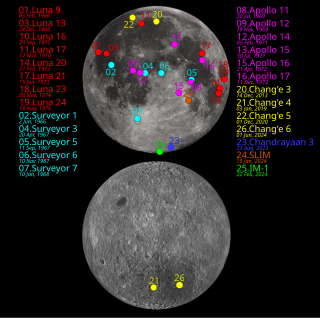
Atlas is a prominent lunar impact crater that is located in the northeast part of the Moon, to the southeast of Mare Frigoris. Just to the west is the slightly smaller but still prominent crater Hercules. Northeast of Atlas is the large crater Endymion.

A Moon landing or lunar landing is the arrival of a spacecraft on the surface of the Moon, including both crewed and robotic missions. The first human-made object to touch the Moon was Luna 2 in 1959.

A lunar lander or Moon lander is a spacecraft designed to land on the surface of the Moon. As of 2024, the Apollo Lunar Module is the only lunar lander to have ever been used in human spaceflight, completing six lunar landings from 1969 to 1972 during the United States' Apollo Program. Several robotic landers have reached the surface, and some have returned samples to Earth.

A rover is a planetary surface exploration device designed to move over the rough surface of a planet or other planetary mass celestial bodies. Some rovers have been designed as land vehicles to transport members of a human spaceflight crew; others have been partially or fully autonomous robots. Rovers are typically created to land on another planet via a lander-style spacecraft, tasked to collect information about the terrain, and to take crust samples such as dust, soil, rocks, and even liquids. They are essential tools in space exploration.

Hakuto (ハクト) or formerly White Label Space (ホワイトレーベルスペース) was a team formed in early 2008 by a group of experienced space professionals inspired by the challenge of the Google Lunar X PRIZE to develop a robotic Moon exploration mission.

A lunar rover or Moon rover is a space exploration vehicle designed to move across the surface of the Moon. The Apollo program's Lunar Roving Vehicle was driven on the Moon by members of three American crews, Apollo 15, 16, and 17. Other rovers have been partially or fully autonomous robots, such as the Soviet Union's Lunokhods, Chinese Yutus, Indian Pragyan, and Japan's LEVs. Five countries have had operating rovers on the Moon: the Soviet Union, the United States, China, India, and Japan.
The (Japanese) Lunar Exploration Program is a program of robotic and human missions to the Moon undertaken by the Japanese Aerospace Exploration Agency (JAXA) and its division, the Institute of Space and Astronautical Science (ISAS). It is also one of the three major enterprises of the JAXA Space Exploration Center (JSPEC). The main goal of the program is "to elucidate the origin and evolution of the Moon and utilize the Moon in the future".

The UAE Space Agency (UAESA) is the space agency of the United Arab Emirates government responsible for the development of the country's space industry. It was created in 2014 and is responsible for developing and regulating the space sector in the UAE.

Smart Lander for Investigating Moon (SLIM) was a lunar lander mission of the Japan Aerospace Exploration Agency (JAXA). The lander's initial launch date in 2021 was postponed until 2023 due to delays in its rideshare, the X-Ray Imaging and Spectroscopy Mission (XRISM). On 6 September 2023 at 23:42 UTC, XRISM launched, and SLIM separated from it later that day.

The year 2022 witnessed the number of launches of SpaceX's Falcon rocket family surpassing the CNSA's Long March rocket family, making the United States the country with the highest number of launches in 2022 instead of China. This year also featured the first successful launch of Long March 6A, Nuri, Angara 1.2, Vega C, Kinetica-1, and Jielong-3. National space agencies' activities in this year is also marred by the Russian invasion of Ukraine, leading to tension between Roscosmos and Western space agencies, threats of ending collaboration on the International Space Station (ISS), and delays on space missions.

Commercial Lunar Payload Services (CLPS) is a NASA program to hire companies to send small robotic landers and rovers to the Moon. Most landing sites are near the lunar south pole where they will scout for lunar resources, test in situ resource utilization (ISRU) concepts, and perform lunar science to support the Artemis lunar program. CLPS is intended to buy end-to-end payload services between Earth and the lunar surface using fixed-price contracts. The program achieved the first landing on the moon by a commercial company in history with the IM-1 mission in 2024. The program was extended to add support for large payloads starting after 2025.
ispace Inc. is a publicly traded Japanese company developing robotic spacecraft and other technology to compete for both transportation and exploration mission contracts from space agencies and other private industries. ispace's mission is to enable its clients to discover, map, and use natural lunar resources.

The Intuitive Machines Nova-C, or simply Nova-C, is a class of lunar landers designed by Intuitive Machines (IM) to deliver small payloads to the surface of the Moon. Intuitive Machines was one of three service providers awarded task orders in 2019 for delivery of NASA science payloads to the Moon. The IM-1 lunar lander, named Odysseus, was launched by a SpaceX Falcon 9 rocket on 15 February 2024, reached lunar orbit on 21 February, and landed on the lunar surface on 22 February. This marked the inaugural Nova-C landing on the Moon and the first American spacecraft to perform a soft landing on the Moon in over 50 years. It is the first spacecraft to use methalox propulsion to navigate between the Earth and the Moon.

The Emirates Lunar Mission was the first mission to the Moon from the United Arab Emirates.
Sora-Q is a miniature Lunar rover designed and made by Japanese space agency JAXA, toy manufacturer Tomy, Sony, and Doshisha University.
Firefly Aerospace Blue Ghost, or simply Blue Ghost, is a class of lunar landers designed by Firefly Aerospace to deliver small payloads to the surface of the Moon. The first Blue Ghost mission is planned to launch in 2024.

Hakuto-R Mission 2 is a robotic lunar landing mission planned for December 2024. Developed by ispace, the lander will deliver a new micro rover manufactured by the company, and other payloads. Like Hakuto-R Mission 1 this mission will serve as a technology demonstration, with the final goal of providing reliable transportation and data services on the moon. The lander is named Resilience.


















